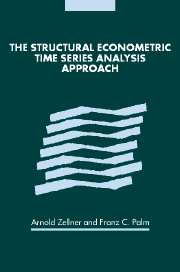Book contents
- Frontmatter
- Contents
- List of contributors
- Acknowledgments
- Introduction
- Part I The SEMTSA approach
- Part II Selected applications
- 6 Time series and structural analysis of monetary models of the US economy (1975)
- 7 Time series versus structural models: a case study of Canadian manufacturing inventory behavior (1975)
- 8 Time series analysis of the German hyperinflation (1978)
- 9 A time series analysis of seasonality in econometric models (1978)
- 10 The behavior of speculative prices and the consistency of economic models (1985)
- 11 A comparison of the stochastic processes of structural and time series exchange rate models (1987)
- 12 Encompassing univariate models in multivariate time series: a case study (1994)
- Part III Macroeconomic forecasting and modeling
- Part IV Disaggregation, forecasting, and modeling
- Subject index
- Author index
- References
11 - A comparison of the stochastic processes of structural and time series exchange rate models (1987)
Published online by Cambridge University Press: 24 October 2009
- Frontmatter
- Contents
- List of contributors
- Acknowledgments
- Introduction
- Part I The SEMTSA approach
- Part II Selected applications
- 6 Time series and structural analysis of monetary models of the US economy (1975)
- 7 Time series versus structural models: a case study of Canadian manufacturing inventory behavior (1975)
- 8 Time series analysis of the German hyperinflation (1978)
- 9 A time series analysis of seasonality in econometric models (1978)
- 10 The behavior of speculative prices and the consistency of economic models (1985)
- 11 A comparison of the stochastic processes of structural and time series exchange rate models (1987)
- 12 Encompassing univariate models in multivariate time series: a case study (1994)
- Part III Macroeconomic forecasting and modeling
- Part IV Disaggregation, forecasting, and modeling
- Subject index
- Author index
- References
Summary
Zellner and Palm (1974) show that comparing the actual with the implied stochastic processes generating the endogenous variables in a system of dynamic structural equations provides important information about the system's correct specification. We apply their methodology to structural exchange rate models. We find that the log of the bilateral exchange rate is generally well approximated by a random-walk model. This implies that the stochastic processes generating the exogenous variables should also be random-walk models. Our empirical results, however, show that this is not, in general, the case. We conclude by suggesting a reconciliation of our results based on a technique developed by Beveridge and Nelson (1981).
Introduction
… [T]heories of exchange rate determination have emphasized the asset approach to foreign exchange markets. As an asset price, the exchange rate is seen as adjusting rapidly and freely to maintain stock equilibrium. For example, in the pure monetary approach, the exchange rate is determined when the total stocks of outstanding foreign and domestic moneys are held willingly by economic agents (see, e.g., Dornbusch 1976; Bilson 1978; Frenkel 1978; Frankel 1983; Hoffman and Schlagenhauf 1983; Huang 1984). Moreover, expectations of future exchange rate movements play a dominant role in determining the current spot rate. This linkage of expectations to the current spot rate is usually accomplished by assuming that uncovered interest rate parity holds, that the foreign exchange market is efficient, and that expectations about the future spot rate are formed rationally.
- Type
- Chapter
- Information
- The Structural Econometric Time Series Analysis Approach , pp. 405 - 417Publisher: Cambridge University PressPrint publication year: 2004



